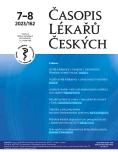Reproductive plan of women in Czechia in the context of late reproductive regime and the COVID-19 pandemic
Authors:
Jitka Slabá 1; Eva Waldaufová 1; Anna Šťastná 1, 2
Authors‘ workplace:
Katedra demografie a geodemografie PřF UK v Praze
1; Výzkumný ústav práce a sociálních věcí, v. v. i, Praha
2
Published in:
Čas. Lék. čes. 2023; 162: 314-320
Category:
Original Article
Overview
The article focuses on short-term (up to three years) and long-term (three years and beyond) reproductive intentions of women aged 18–49 living in the Czechia.
Reproductive plans are predominantly formulated at the threshold of adulthood and only 11 % of women under 25 are unsure of their reproductive plans. In the short term, childbearing is planned with the greatest intensity at the ages of 25–29 and 30–34 (when 47 and 33 % of women plan to have a child, respectively), while for childless women the intensity of planning peaks slightly later, at the ages of 30–34 and 35–39 (planning rates of 54 and 50 %, respectively).
Older women are not giving up their desire to pursue their reproductive plans. Despite the health risks associated with motherhood at an older age, 20 % of childless women aged 40–44 plan to have their first child in the next three years or later.
In addition to age and the current number of children, short- and long-term reproductive plans also differ by women’s education, with college graduates more likely to plan to have (another) child in the short and long term than women with less education. At the same time, short-term plans are influenced by women's partnership status, and in the case of long-term reproductive plans, the influence of perceptions of the long-term impact of the COVID-19 pandemic was observed.
Keywords:
short-term reproductive plans, long-term reproductive plans, COVID-19 pandemic, late reproduction, Czech Republic
Sources
- Kocourková J, Šťastná A, Idlbeková B, Slabá J. Trendy plodnosti a potratovosti v Česku. Časopis lékařů českých 2023; 162 (7–8): 299–306.
- Lesthaeghe R. The unfolding story of the second demographic transition. Pop Dev Rev 2010; 36 (2): 211–251.
- Chromková Manea BE, Rabušic L. Marriage, childbearing and single motherhood: trends in attitudes and behaviour in Czechia and Slovakia from 1991 to 2017. Sociální studia 2019; 16 (2): 25–50.
- Kohler HP, Billari FC, Ortega JA. The emergence of lowest‐low fertility in Europe during the 1990s. Pop Dev Rev 2002; 28 (4): 641–680.
- Rychtaříková J. Is Eastern Europe experiencing a second demographic transition? AUC Geographica 1999; 34 (1): 19–49.
- Šťastná A. Druhé dítě v rodině – preference a hodnotové orientace českých žen. Sociologický časopis 2007; 43 (4): 721–745.
- Chromková Manea BE, Rabušic L. Male fertility in the Czech Republic – first empirical evidence. Demografie 2013; 55 (4): 275–290.
- Sobotka T, Beaujouan É. Two is best? The persistence of a two-child family ideal in Europe. Pop Dev Rev 2014; 40 (3): 391–419.
- Kuchařová V, Barvínková J, Höhne S a kol. Česká rodina na počátku 21. století. Životní podmínky, vztahy a potřeby. SLON, Praha, 2019.
- Kocourková J, Slabá J, Šťastná A. The role of cohorts in the understanding of the changes in fertility in Czechia since 1990. AUC Geographica 2022; 57 (1): 61–74.
- Slabá J. Changes in reproductive behavior associated with the perception and individual experiences of the COVID-19 pandemic. PLoS One 2023; 18 (7): e0288833.
- Kreidl M, Šťastná A, Kocourková J et al. Czech Harmonized Generations and Gender Survey-II. Wave 1 (2020–2022). Version 1. 2023. Data obtained from the GGP Data Archive.
- Kreidl M, Šťastná A, Hubatková B et al. Současná česká rodina: dokumentace k datům. MUNI Press, Brno, 2023.
- Slabá J. Vládní boj proti pandemii: přehled opatření vydaných v souvislosti s pandemií onemocnění COVID-19 v Česku v letech 2020 a 2021. Demografie 2022; 64 (2): 175–196.
- Šťastná A, Volejníková A. Reprodukční stárnutí a problémy s neplodností. Časopis lékařů českých 2023; 162 (7–8): 321–329.
- Řežábek K. Asistovaná reprodukce (3., aktualizované a doplněné vyd.). Maxdorf, Praha, 2018.
- Šťastná A, Fait T, Kocourková J, Waldaufová E. Does advanced maternal age comprise an independent risk factor for caesarean section? A population-wide study. Int J Environ Res Public Health 2022; 20 (1): 668.
- Hašková H, Pospíšilová K. Kdo plánuje jedináčka a kdo chce zůstat bezdětný? Faktory ovlivňující nízké reprodukční plány mužů a žen. Sociologický časopis 2020; 2: 131–164.
- Kocourková J, Šťastná A, Slabá J a kol. Změny v reprodukčním chování a reprodukční stárnutí. Souhrnná výzkumná zpráva z šetření Současná česká rodina 2020–2022. Přírodovědecká fakulta UK, Praha, 2023.
- Kocourková J, Šťastná A. The realization of fertility intentions in the context of childbearing postponement: comparison of transitional and post-transitional populations. J Biosoc Sci 2021; 53 (1): 82–97.
- Berrington A. Perpetual postponers? Women's, men's and couple's fertility intentions and subsequent fertility behaviour. Population Trends 2004; 117: 9–19.
- Beaujouan É, Reimondos A, Gray E et al. Declining realisation of reproductive intentions with age. Hum Reprod 2019; 34 (10): 1906–1914.
- Kuhnt AK, Trappe H. Channels of social influence on the realization of short-term fertility intentions in Germany. Adv Life Course Res 2016; 27: 16–29.
- Tarlatzis BC, Zepiridis L. Perimenopausal conception. Ann N Y Acad Sci 2003; 997: 93–104.
- Šťastná A, Kocourková J. Věk nástupu menopauzy v závislosti na věku prvního porodu. Časopis lékařů českých 2023; 162 (7–8): 330–336.
Labels
Addictology Allergology and clinical immunology Angiology Audiology Clinical biochemistry Dermatology & STDs Paediatric gastroenterology Paediatric surgery Paediatric cardiology Paediatric neurology Paediatric ENT Paediatric psychiatry Paediatric rheumatology Diabetology Pharmacy Vascular surgery Pain management Dental HygienistArticle was published in
Journal of Czech Physicians

Most read in this issue
- Artificial intelligence in medicine and healthcare: Opportunity and/or threat
- Trends in fertility and abortion in Czechia
- Zogala D. Artificial intelligence in medical imaging
- Questions and questionnaires about acute climacteric syndrome
